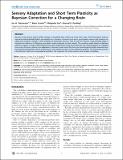Sensory Adaptation and Short Term Plasticity as Bayesian Correction for a Changing Brain
Author(s)
Stevenson, Ian H.; Cronin, Beau; Sur, Mriganka; Kording, Konrad P.
DownloadStevenson-2010-Sensory Adaptation a.pdf (626.3Kb)
PUBLISHER_CC
Publisher with Creative Commons License
Creative Commons Attribution
Terms of use
Metadata
Show full item recordAbstract
Neurons in the sensory system exhibit changes in excitability that unfold over many time scales. These fluctuations produce noise and could potentially lead to perceptual errors. However, to prevent such errors, postsynaptic neurons and synapses can adapt and counteract changes in the excitability of presynaptic neurons. Here we ask how neurons could optimally adapt to minimize the influence of changing presynaptic neural properties on their outputs. The resulting model, based on Bayesian inference, explains a range of physiological results from experiments which have measured the overall properties and detailed time-course of sensory tuning curve adaptation in the early visual cortex. We show how several experimentally measured short term plasticity phenomena can be understood as near-optimal solutions to this adaptation problem. This framework provides a link between high level computational problems, the properties of cortical neurons, and synaptic physiology.
Date issued
2010-08Department
Massachusetts Institute of Technology. Department of Brain and Cognitive Sciences; Picower Institute for Learning and MemoryJournal
PLoS One
Publisher
Public Library of Science
Citation
Stevenson, Ian H. et al. “Sensory Adaptation and Short Term Plasticity as Bayesian Correction for a Changing Brain.” PLoS ONE 5.8 (2010): e12436.
Version: Final published version
ISSN
1932-6203